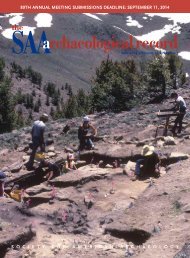SAA
Nov2016_web
Nov2016_web
Create successful ePaper yourself
Turn your PDF publications into a flip-book with our unique Google optimized e-Paper software.
VIDEO GAMES AND ARCHAEOLOGY<br />
Figure 2. Survey results indicating the importance, enjoyment, and representativeness of archaeology in games for all respondents. Image by VALUE.<br />
collecting artifacts: “It is more looting than actual archaeology.”<br />
Secondly, respondents stated that “real” archaeology is<br />
not exciting or not popular enough for games: “Archaeology<br />
is not really exciting for most people, while video games<br />
should be exciting.” And finally, the biggest issue relating to<br />
representation was that video games are fiction, far from the<br />
truth or inaccurate: “Lots of things are popularized and not<br />
correct.”<br />
There were a few people who responded positively on the<br />
potential benefits of representing archaeology in video<br />
games: “If done in a proper way it can be very useful for<br />
archaeology” and “It can create a lot of public awareness.”<br />
How can archaeology in games still be enjoyable, while also<br />
contributing some educational, scholarly, and societal value?<br />
Our survey did not provide an answer to this, but we have<br />
some suggestions based on our engagements with the intersections<br />
of games and archaeology over the past year. These<br />
took the form of thematic sessions in which issues of archaeological<br />
importance were featured in discussions while playing<br />
games that illustrated these topics.<br />
Recent Examples<br />
It is quite common for games to attempt to reconstruct monuments<br />
or cities of the past. With some notable exceptions<br />
(i.e. the Assassin’s Creed series), this is done without significant<br />
contributions by archaeologists and historians. This has<br />
resulted in chronological errors, inaccurate representations,<br />
and false perceptions of past societies. Dunstan Lowe, by surveying<br />
different games, has written about the practice of representing<br />
the Greek and Roman past as a landscape of ruins<br />
rather than as living cities (2013:84–85).<br />
There are other examples of games that seek to provide<br />
authenticity in their gaming worlds through extensive historical<br />
and material research. A recent example, released in<br />
2014, is Valiant Hearts by Ubisoft Montpellier. This game is<br />
set in World War I, a rare setting for a video game. It roughly<br />
follows the course of history, taking players through actual<br />
events like the battle of the Somme and the battle of the<br />
Marne. The perspective of the game is viewed through the<br />
personal stories of a few ordinary people who struggle on<br />
opposite sides of the war rather than a top-down approach of<br />
the player commanding armies and battles. 5 To give players<br />
November 2016 • The <strong>SAA</strong> Archaeological Record<br />
13




